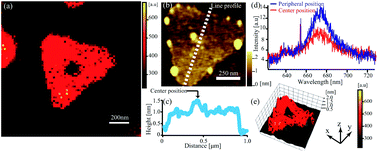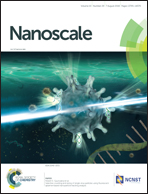Probing the nanoscale light emission properties of a CVD-grown MoS2 monolayer by tip-enhanced photoluminescence
Abstract
Two-dimensional transition metal dichalcogenides are gaining increasing interest due to their promising optical properties. In particular, molybdenum disulfide (MoS2) which displays a band-gap change from indirect at 1.29 eV for bulk materials to direct at 1.8 eV for the material monolayer. This particular effect can lead to a strong light interaction which can pave the way for a new approach to the next generation of visible light emitting devices. In this work we show the nanoscale variation of light emission properties by tip-enhanced photoluminescence microscopy and spectroscopy in the MoS2 monolayer, grown by chemical vapour deposition. The variations of the light emission properties are due to different effects depending on the shape of the MoS2 single layer, for instance, a different concentration of point defect in an irregularly shaped flake and the presence of a nanoscale terrace in a triangular monolayer. Simultaneously, atomic force microscopy reveals indeed the presence of a nanometric terrace, composed of an additional layer of MoS2, and tip-enhanced PL intensity imaging shows a localized intensity decrease.

- This article is part of the themed collection: Editor’s Choice: Optical Spectroscopy of 2D materials


 Please wait while we load your content...
Please wait while we load your content...